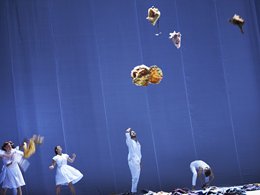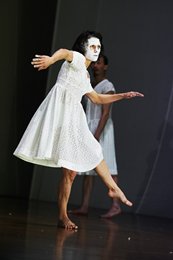In Fabulous Beast’s dance double-bill for the Galway Arts Festival, Stravinsky’s Petrushka is the follow-up to the more controversial The Rite of Spring: it’s a sort of sensible sister smoothing the troubled waters stirred up by the nudity, humping, hares and hounds of Michael Keegan-Dolan’s preceding Rite.
In a way, however, the pairing of these two particular productions is tricky: the disturbing, violently aggressive drama of The Rite of Spring haunts Petrushka’s more lyrical and optimistic mood. Petrushka’s pallid set and white-dressed dancers are rather overshadowed by its predecessor’s uninhibited exhibitionism, visual impact and conscious efforts to echo the very first production’s riot-forming controversy. And yet this Petrushka pays enormous respect to Stravinsky’s music and is an admirably coherent presentation. Less dependent on overt showmanship, with fewer opportunities for dancers to exhibit their individuality (a feature of the choreography in The Rite of Spring), Petrushka is more stylistically conventional but just as engaging.
 Keegan-Dolan makes explicit links between the two dance pieces. The actors discard their Rite costumes and ball them up into a sheet at the opening; snow, chilling in The Rite, is cast around like confetti here; actor Bernadette Iglich retains her ‘cailleach’ persona (long hair, dour looks and black clothing) from The Rite and becomes Petrushka’s puppet-master (the ‘Magician’ or ‘Charlatan’) precariously perched high up on a lighting rig to the side and fore of the space. Beneath her, actor Bill Lengfelder, her gaffer in the previous work, glowers at the cast. With sepia photographs of Stravinsky and Nijinsky beside her almost as if they were overseeing the action themselves, Iglich directs proceedings with hand-held follow-spot and the odd surreptitious nod. Like marionettes, the troupe gazes up at her at times as if for direction.
Keegan-Dolan makes explicit links between the two dance pieces. The actors discard their Rite costumes and ball them up into a sheet at the opening; snow, chilling in The Rite, is cast around like confetti here; actor Bernadette Iglich retains her ‘cailleach’ persona (long hair, dour looks and black clothing) from The Rite and becomes Petrushka’s puppet-master (the ‘Magician’ or ‘Charlatan’) precariously perched high up on a lighting rig to the side and fore of the space. Beneath her, actor Bill Lengfelder, her gaffer in the previous work, glowers at the cast. With sepia photographs of Stravinsky and Nijinsky beside her almost as if they were overseeing the action themselves, Iglich directs proceedings with hand-held follow-spot and the odd surreptitious nod. Like marionettes, the troupe gazes up at her at times as if for direction.
Sinister master-of-ceremonies aside, there are no explicit references here to the original (Diaghilev/Fokine/Benois) libretto. Whereas Stravinsky and his dramaturgs used Russian fairs, dances and folk characters to tell the story of a puppet that develops human emotions, Keegan-Dolan dispenses with this narrative and any link to the original drama is merely hinted at. Perhaps themes of the original ballet that explore the conflict of individuality with uniformity are nodded at in the way that movements initiated by one dancer are then repeated by the corps de ballet: repetitive, sweeping arm gestures pass amongst them like a Mexican wave. Then the daubing of the performers in white smears of face-paint may hint at both the confusion between puppet and human and also pay homage to Benois’ original petrushka (pierrot-like) doll designs of 1911. However, Benois’ riot of colour is purged in this version and, danced in designer Rae Smith’s white-sheeted marquee-like box by smiling performers costumed in Doey Lüthi's swirling white summer dresses, Keegan-Doolan’s Petrushka would seem to be a more optimistic world where Petrushka finally transcends a rather benign humanity by ascending a white rope ladder hanging from the rafters.
 Whatever narrative an audience invents to frame the choreography, most distinctive about this thoroughly attractive production is the witty relationship created between music and movement. Fabulous Beast’s is an entirely musical Petrushka.
Whatever narrative an audience invents to frame the choreography, most distinctive about this thoroughly attractive production is the witty relationship created between music and movement. Fabulous Beast’s is an entirely musical Petrushka.
Stravinsky’s score is a cheeky neo-classical whirling dervish where Russian folk tunes merge with a more atonal neo-classicism, and waltzes collapse out of conventional time and tonality. On this stage, it is reflected in the various angular pas-de-deux, the sinuous and the earthy departures from balletic convention in the troupe work, and also the humour in the interplay between the ‘Magician’ and her wards. The juxtaposition of classicism with modernity and musical puns in Stravinsky’s music are neatly and appropriately marked in the choreography. Above all, the work allows the considerable abilities of pianist sisters Lidija and Sanja Bizjak to shine and both virtuosi are integral to the drama: they are led to their piano by the cailleach in Rite, identically costumed in neat black frocks and brightly lit. Their hard work rightly drives everything on the stage.
While The Rite of Spring is copiously endowed with naked bodies, masks and high dramatic jinks, Petrushka is a more polite, more restrained and wittier sibling. However, they complement and refer kindly to each other, and, in the end, like the two pianists front of stage, they are both equally fascinating.
Matthew Harrison
Read Helen Meany's review of Fabulous Beast's The Rite of Spring on its 2009 premiere in London here.